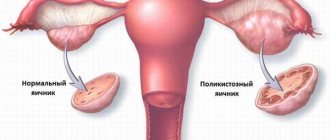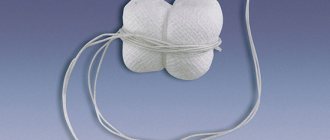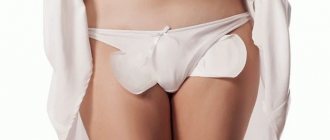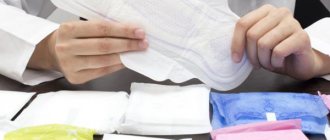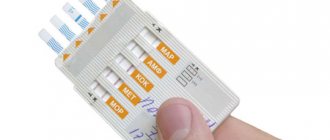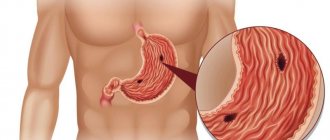Tampons as we know them came onto the market in the early twentieth century. They were not popular because they were inconvenient and even dangerous. The tampons were wrapped in gauze, with which they had to be pulled out.
They took on a more modern look at the end of the same century. After their use, several female deaths were noted, which is why the question became relevant: is using tampons harmful and to what extent? As it turned out later, the cause of death was infectious-toxic shock, which developed due to the release of exotoxins from various bacteria. The synthetic fibers from which the products were made became fertile ground for the existence of bacteria.
Modern tampons are made from materials such as cotton and rayon, so the risk of TSI is quite low. But since there is an episode in the history of mankind characterized by mortality from the use of tampons, there is still debate among doctors and specialists about the dangers and benefits.
Main myths:
- Defloration. They do not damage the hymen, so even girls can use them. The hymen itself becomes more elastic and expands during menstruation.
- Fluid stagnation. When using a tampon, there is no accumulation of fluid inside the vagina, since the material from which the hygiene product consists absorbs secretions and passes them through itself.
- Loss of a tampon inside the reproductive system. After the tampon is inserted correctly, it is clamped by the vaginal muscles, so that it does not move inside the woman and is easily removed after use using a special thread.
https://youtu.be/8q0xP6VN1ik
General information
The product is made from natural raw materials that absorb moisture. The main material becomes:
- cotton wool;
- viscose.
It is possible to use pressed, stitched fabric.
The classic shape is oblong, cylindrical. Each item is equipped with a durable cord to ensure safe removal from the vagina.
Variants of tampons with cardboard or plastic applicators are common. The applicator consists of two tubes, the first of which is equipped with petals and is rounded on one side. Using this part, the tampon is pushed towards the entrance to the vagina, pressing on the second, inner tube, which pushes out the absorbent part. When used, the thread remains outside, and the tubes are connected into one. The applicator ensures the safety of the mucous membrane: the tissue will not be damaged even if the device is inserted carelessly.
Choosing the right one
Knowing how to choose tampons is necessary so as not to harm your body.
The most convenient are devices equipped with an applicator.
How much a tampon absorbs is indicated on the packaging. An international blob notation system has been developed to indicate intensity. The more symbols, the greater the volume of secretions absorbed.
Different brands of tampons use the same designations. Since the days of the menstrual cycle differ in the amount of discharge, the benefits are noticeable if you choose your own option for each new day. Special “night” tampons have also been developed.
Scented products are attractive, but are not recommended for women prone to allergies.
What to look for when purchasing?
Are tampons dangerous? A woman turning to these hygiene products for the first time is rightly afraid of getting an infection or harming internal tissues by inept handling of the product.
Before use, first read the instructions. Despite the versatility of hygiene products, specific models may differ slightly from each other.
Doctors recommend choosing products labeled “mini” for the first time, that is, the minimum size. The overwhelming percentage of women use a normal size (labeled “normal”), but in a particular case you will have to find out empirically.
Small and medium tampons are easier to insert. Harm and benefit directly depend on the choice of the appropriate option. When the maximum possible volume of discharge is absorbed in a short time and leakage is observed, it is worth trying to replace the size with a larger one.
Advantages
When using tampons during menstruation, the benefits are noticeable: the woman does not suffer from the characteristic odor, since contact of the discharge with air is excluded.
Therapeutic tampons have been developed. They absorb menstrual fluid and have a positive effect on the mucous membranes, soothing them thanks to the herbal extracts included in the composition. The benefits of such products are undeniable.
Hygiene products are invisible. The products can be used with a transparent dress, short skirt, or thong panties.
Tampons are a guarantee of hygiene, which comes to the fore during menstruation.
Menstruation weakens the body, makes a woman defenseless against infections, especially of the genital tract, and classic pads cannot prevent the pathogen from penetrating the mucous membrane. The benefit of tampons when used correctly is to prevent infection of an open wound in the uterus by pathogenic bacteria.
Why is it recommended to change your tampon frequently?
Of course, you can’t wear such an intimate hygiene product constantly and continuously either. Firstly, with heavy discharge, it can simply overflow, and the woman will not have time to keep track of this. Confusion may occur in the form of leakage of discharge. A situation of toxic shock is also possible if it remains inside the vagina for a long time. But the main reason for the need to constantly change a tampon is much simpler.
The fact is that the blood released during menstruation is dead. And if it is concentrated in one place for a long time, then the process of decomposition and rotting begins. This is why it is recommended to change your tampon frequently to prevent infection and possible toxic shock.
These rules are very obvious, and if you constantly adhere to them, then menstruation will pass painlessly and almost unnoticed. Nowadays, with a huge range of personal hygiene products for women, you can easily get confused.
The main thing is to remember that a correctly selected tampon will allow a woman to feel 100% confident and not be afraid of leaks.
Is there any harm?
Harm to the body can be caused by inept use of hygiene products.
How long can you walk with one tampon? No more than 4 hours. Even when choosing a “maxi” size, when the discharge is small in volume, you cannot use the item for longer. Otherwise, pathogenic microorganisms begin to multiply in the blood-soaked tampon. This provokes the development of inflammation of the genital organs, thrush, etc. With the rapid proliferation of Staphylococcus aureus, pyogenic streptococci, clostridia, the development of infectious-toxic shock is possible.
The use of an absorbent tampon at the beginning and end of menstrual bleeding, when the bleeding is light, is not recommended, as it provokes irritation and dryness of the vaginal mucosa.
If the use of such hygiene products is contraindicated for a woman, the harm of tampons is obvious. The restrictions are:
- inflammation of the genital organs;
- tendency to allergies (you can’t use scented products, others - carefully, monitoring the body’s reaction);
- individual features of the structure of the hymen;
- feeling of vaginal dryness after use;
- treatment with vaginal local medications (the tampon will absorb the medications).
To absorb daily secretions outside of menstrual bleeding, using tampons is to your detriment.
It is not recommended to use them at night, since microscopic cracks appear on the mucous membrane during menstruation, the healing of which is slowed down if the tampon is in the vagina.
Virgins should not use tampons unless absolutely necessary. Even the smallest tampon can damage the hymen. Before you start using tampons, it is a good idea to consult your doctor.
The production of tampons uses substances that can also harm women's health:
- Dioxin. This is a bleaching component that, when concentrated in the body, causes cells to degenerate into malignant ones. In women, this substance provokes endometriosis. As for dangerous concentrations, opinions are divided. A group of scientists is convinced that even a minimal dose is harmful to humans, since decomposition takes a long time and dioxin accumulates in the body. Others are convinced that the concentration of the component in sanitary tampons is so insignificant that there can be no talk of any danger.
- Viscose. The substance is made from wood and absorbs secretions. During production, the fibers are treated with chemicals that are absorbed into the fabric. Viscose is a strong absorbent; after removing the used item, tiny fibers remain on the mucous membrane and their components cause harm to the female body for a long time.
- Cotton. A genetically modified product is used that causes the body cells in contact with it to become resistant to antibiotics. Women who regularly use such tampons are more likely to encounter inflammatory processes that are difficult to treat.
Symptoms of intoxication and improper use of a tampon
Violating the rules for using tampons and untimely replacement can cause serious health problems. One possible consequence is the appearance of toxic shock syndrome. The disease is rare, but very dangerous. The reason is bacteria that enter the body and release toxic substances. The pathological condition during intoxication develops quickly, and the accumulation of toxins does not go unnoticed. The symptoms are very clear:
- a sharp increase in temperature;
- vomit;
- nausea;
- diarrhea;
- dizziness;
- severe chills, muscle cramps and aches;
- skin rashes.
Adverse consequences can be avoided. It is enough to insert the tampon correctly into the vagina and not exceed the wearing time. If you fail to protect yourself and symptoms of intoxication appear, consult a doctor immediately. Toxic shock syndrome is a serious and complex condition. Harmful microorganisms can penetrate the tissues of the brain, kidneys and liver. Activated carbon and other sorbents cannot cope with such amounts of toxic waste. It will not be possible to recover without the help of a specialist.
During menstruation, special attention should be paid to genital hygiene. I think there is no need to remind you how often you need to wash your face and change your underwear. I will just give some recommendations on choosing hygiene products.
Sanitary napkin
Nowadays, there are many different hygiene products that help a woman feel comfortable during her “critical days.” Sanitary pads are ideal. They vary in thickness (from 3 to 12 mm), shape, structure, and amount of moisture absorbed. Gaskets are also available with or without wings.
Which one you prefer is up to you. The highest quality and most popular gaskets today are Always, Libresse and Cotex.
Which gaskets should I choose?
Every woman knows how heavy her bleeding is during menstruation. It is very important to choose pads with the desired absorption coefficient. There are usually three of them: NORMAL, SUPER and SUPER PLUS (NIGHT). But depending on the manufacturer, this quantity, as well as the names of the coefficients, may vary.
For women with heavy discharge, SUPER or SUPER PLUS pads are most suitable. In this case, as well as during night sleep, gaskets with “wings” are very good, which reliably protect against leakage. Young girls who are not yet sexually active can use NORMAL pads.
How often should gaskets be changed?
This issue is not only aesthetic, since menstrual blood is an ideal habitat for various types of infections. The cervix is slightly open during this period, and almost nothing blocks the path of infection from the external to the internal genital organs. The more often you change pads, the less likely it is that infection will get into the internal genital organs.
Summing up
Some women are convinced that tampons are indispensable in everyday life, the benefits of their use are undeniable, and the harm is insignificant. Conservative people are of the opinion that resorting to tampons should only be used as a last resort.
When choosing hygiene products, remember: health benefits depend on proper use. Follow the manufacturer's recommendations, wear a tampon for no more than 4 hours, change it promptly, and then you don't have to worry about anything.
When planning to use a hygienic absorbent tampon for the first time, choosing a product for a virgin, first consult with a gynecologist.
Read
Also:
- Why do we need hygienic feminine tampons, what types are there?
- Chinese herbal tampons for women, instructions
- How to insert a tampon correctly for the first time, what to do if it gets stuck
- Tampons for girls: can virgins use them?
Can a tampon leak?
If the tampon is inserted correctly and replaced on time, it provides reliable protection during menstruation: it does not cause discomfort, effectively absorbs discharge and does not leak.
Knowing when to change a tampon comes with experience. But remember that in any case, the hygiene product must be changed no later than 8 hours from the time of administration (even if it seems to you to be insufficiently filled). Let us explain once again: if your tampon is leaking, it is either selected or inserted incorrectly.
ob® have developed a comprehensive line of products, including ProComfort™ and ProComfort™ Night tampons, available in varying absorbency levels to provide reliable protection every day and every night. Try the ob® Tampon Selector. He will help you choose the right hygiene product and the degree of absorbency in accordance with your needs.
